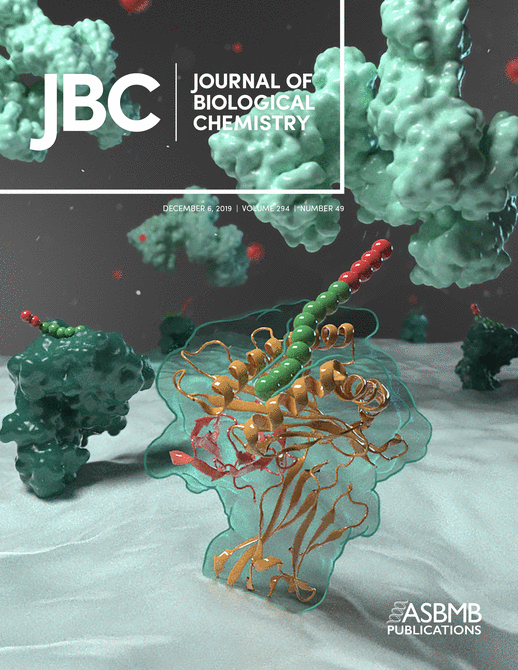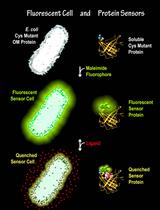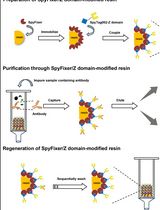- EN - English
- CN - 中文
In vitro Assay for Bacterial Membrane Protein Integration into Proteoliposomes
细菌膜蛋白在蛋白质脂质体中的体外整合
发布: 2020年05月20日第10卷第10期 DOI: 10.21769/BioProtoc.3626 浏览次数: 4934
评审: David A. CisnerosAgnieszka ZienkiewiczSandeep Dave
Abstract
It is important to experimentally determine how membrane proteins are integrated into biomembranes to unveil the roles of the integration factors, and to understand the functions and structures of membrane proteins. We have developed a reconstitution system for membrane protein integration in E. coli using purified factors, in which the integration reaction in vivo is highly reproducible. This system enabled not only analysis of membrane-embedded factors including glycolipid MPIase, but also elucidation of the detailed mechanisms underlying membrane protein integration. Using the system, the integration of membrane proteins can be evaluated in vitro through a protease-protection assay. We report here how to prepare (proteo)liposomes and to determine the activities of membrane protein integration.
Keywords: Membrane protein integration (膜蛋白整合)Background
Membrane proteins and presecretory proteins, synthesized in the cytosol, are integrated into and translocated across biomembranes, respectively, to be localized at their destinations and to express their functions. Cells possess systems to integrate membrane proteins into and translocate presecretory proteins across biomembranes, these proteins being commonly conserved from bacteria to higher eukaryotes.
In E. coli, a model organism, some integration factors were identified through genetic approaches, these factors including translocon SecYEG (Newitt and Bernstein, 1998), and signal recognition particle (SRP) and its receptor SR (Ulbrandt et al., 1997), and membrane protein insertase/chaperone YidC (Samuelson et al., 2000). These genetic studies were complemented by biochemical approaches. The molecular mechanisms underlying membrane protein integration have been studied extensively using an in vitro system, in which the protein integration reactions were reproduced in test tubes.
Inverted membrane vesicles (INV) can be prepared by disrupting E. coli cells with a French press, followed by sucrose gradients (Alami et al., 2002). The outside surface of INV corresponds to the cytoplasmic face of the inner membrane. Therefore, presecretory proteins are translocated into the lumen of INV. Membrane proteins, synthesized outside of INV using the cell-free translation system, are integrated into INV. The roles of the above-mentioned factors have been analyzed using INV prepared from the respective mutant cells (Koch et al., 1999; Koch and Muller, 2000). However, since most of the factors are essential for cell growth, depletion of each of the factors causes unexpected pleiotropic effects. To exclude such secondary effects, a reconstitution system has been developed using purified factors. Proteoliposomes can be prepared by mixing membrane proteins, solubilized and purified in a detergent solution, and phospholipids, followed by removal of the detergent. The reconstituted proteoliposomes are essentially the same as INV and thus they can be directly used in the integration assay in vitro. On the other hand, disordered spontaneous integration of membrane proteins into liposomes formed of phospholipids is a serious problem, since such spontaneous integration is an in vitro artefact that does not reflect the reaction in vivo. We have solved this problem by introducing diacylglycerol (DAG) into the liposomes (Nishiyama et al., 2006; Kawashima et al., 2008). As a consequence, DAG blocked spontaneous integration at the physiological content, which enabled reconstitution of membrane protein integration. By using such a reconstitution system we identified a glycolipid named MPIase (Membrane Protein Integrase) as an essential factor for membrane protein integration (Nishiyama et al., 2006; Nishiyama et al., 2010). Based on the observation that MPIase catalyzes membrane protein integration (Nishiyama et al., 2010), we proposed that MPIase is a “glycolipozyme” (Nishiyama et al., 2012). We also determined the MPIase structure, in which a glycan chain composed of 9~11 repeats of a unit of three N-acetylated amino sugars, GlcNAc, ManNAcA and Fuc4NAc, is connected to DAG through a pyrophosphate linker (Nishiyama et al., 2012). Thus, membrane protein integration can be reproduced by introducing lipid components such as DAG and MPIase into reconstituted proteoliposomes.
Recently, we found another problem when reconstituting proteoliposomes. DAG is not only solubilized by a series of detergents such as dodecyl maltoside (DDM) and dodecyl phosphocholine (DPC), but also forms wax-like complexes with them (Sasaki et al., 2019). Since these wax-like complexes induce the spontaneous integration, the detergents must be removed completely from the reconstituted proteoliposomes. On the other hand, DDM and DPC are frequently used to purify the SecYEG complex (Collinson et al., 2001) and YidC (Stiegler et al., 2011; Welte et al., 2012). Therefore, the membrane components should be properly reconstituted without the formation of the unexpected complexes that induce spontaneous integration.
In this protocol, we report a method for reconstituting proteoliposomes containing SecYEG and YidC, but free of the complex of DAG and DDM/DPC. To achieve this, SecYEG and/or YidC were first reconstituted into DAG-free proteoliposomes, followed by membrane fusion with liposomes containing DAG and MPIase by freezing-thawing-sonication, which yielded unilamellar proteoliposomes (Sasaki et al., 2019). Such proteoliposomes are ready for the membrane integration assay. This assay system includes a Pure System, a reconstituted translation system, to in vitro synthesize substrate membrane proteins (Nishiyama et al., 2010; Shimizu et al., 2001). The integration activity was determined by analyzing the membrane protected fragments (MPF) (Koch et al., 1999). The MPFs generated upon protease digestion after the integration reaction reflect the membrane integration.
Materials and Reagents
- Plastic tubes (1.5 ml) (Greiner, catalog number: 616201 )
- Ultracentrifuge tubes (1.5 ml) (Beckman Coulter, catalog number: 357448 )
- Glass vials (2 ml) (AS ONE, catalog number: 9-852-01 )
- Dialysis tubes (Tokyo Garasu Kikai Co., Ltd, catalog number: 0 3272337 )
- E. coli polar lipid extract (phospholipids) (Avanti Polar Lipids, Inc., catalog number: 100600C )
- 1,2-Dioleoyl-sn-glycerol (DAG) (Merck, catalog number: D0138 )
- 2-[4-(2-Hydroxyethyl)-1-piperazinyl]ethanesulfonic acid (HEPES) (Dojindo Laboratories, catalog number: 342-01375 )
- Dithiothreitol (Wako, catalog number: 048-29224 )
- Chloroform, Guaranteed Reagent (Wako, catalog number: 038-02606 )
- Acetone, Guaranteed Reagent (Wako, catalog number: 012-00343 )
- n-Octyl-β-D-glucopyranoside (OG) (Dojindo Laboratory, catalog number: O001 )
- [35S]-EXPRESS Protein Labeling Mix (PerkinElmer Inc, catalog number: NEG072 )
- Pure System (Gene Frontier, catalog number: PF001-0.25 )
- Proteinase K (Roche, catalog number: 03 115 879 001 )
- Trichloroacetic acid, Guaranteed Reagent (Wako, catalog number: 204-02405 )
- Acrylamide, Electrophoresis grade (Wako, catalog number: 011-08015 )
- N,N'-Methylenebis(acrylamide), Electrophoresis grade (Wako, catalog number: 130-06031 )
- Sodium dodecyl sulfate (SDS), for Molecular Biology (Wako, catalog number: 194-13985 )
- 2-Amino-2-hydroxymethyl-1,3-propanediol (Tris), Guaranteed Reagent (Wako, catalog number: 207-06275 )
- Na2HPO4, Guaranteed Reagent (Wako, catalog number: 197-02865 )
- NaH2PO4, Guaranteed Reagent (Wako, catalog number: 192-02815 )
- Glycine, Guaranteed Reagent (Wako, catalog number: 077-00735 )
- Bromophenol Blue (Wako, catalog number: 021-02911 )
- β-Mercaptoethanol (Wako, catalog number: 131-14572 )
- Glycerol, Guaranteed Reagent (Wako, catalog number: 075-00611 )
- Ffh, purified as described (Eisner et al., 2003)
- FtsY, purified as described (Koch et al., 1999)
- YidC, purified as described (Nishikawa et al., 2017)
- SecYEG, purified as described (Moser et al., 2013)
- MPIase, purified as described (Nishiyama et al., 2010 and 2012)
- TALON Metal Affinity Resin (Clontech, catalog number: 635503 )
- Imaging plates (GE, BAS IP MS 2025 E, catalog number: 28-9564-75 )
- Buffer A (see Recipes)
- OG stock (see Recipes)
- Sodium phosphate buffer (pH 7.2) (see Recipes)
Equipment
- Bath-type sonicator (Branson, model: Bransonic 12 )
- Freeze-dryer (EYELA, model: FD-80 )
- Vacuum pump (ULVAC, model: GCD-051X )
- Ultracentrifuge (Beckman Coulter, model: Optima TL )
- Rotor (Beckman Coulter, model: TLA-55 )
- Incubator (Eppendorf, model: Thermomixer Comfort )
- Phosphorimager (GE, model: Storm 820 )
- -80 °C freezer
Software
- ImageQuant software (GE Healthcare)
Procedure
文章信息
版权信息
© 2020 The Authors; exclusive licensee Bio-protocol LLC.
如何引用
Readers should cite both the Bio-protocol article and the original research article where this protocol was used:
- Nishikawa, H., Sasaki, M. and Nishiyama, K. (2020). In vitro Assay for Bacterial Membrane Protein Integration into Proteoliposomes. Bio-protocol 10(10): e3626. DOI: 10.21769/BioProtoc.3626.
- Sasaki, M., Nishikawa, H., Suzuki, S., Moser, M., Huber, M., Sawasato, K., Matsubayashi, H. T., Kumazaki, K., Tsukazaki, T., Kuruma, Y., Nureki, O., Ueda, T. and Nishiyama, K. I. (2019). The bacterial protein YidC accelerates MPIase-dependent integration of membrane proteins. J Biol Chem 294(49): 18898-18908.
分类
生物化学 > 蛋白质 > 合成
分子生物学 > 蛋白质 > 活性
生物化学 > 蛋白质 > 相互作用
您对这篇实验方法有问题吗?
在此处发布您的问题,我们将邀请本文作者来回答。同时,我们会将您的问题发布到Bio-protocol Exchange,以便寻求社区成员的帮助。
提问指南
+ 问题描述
写下详细的问题描述,包括所有有助于他人回答您问题的信息(例如实验过程、条件和相关图像等)。
Share
Bluesky
X
Copy link












